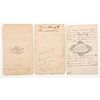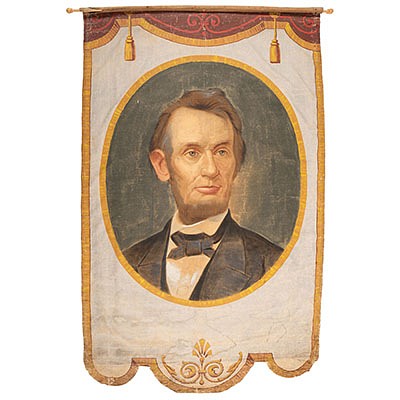[CIVIL WAR]. A group of 3 CDVs of Brown Water Navy gunboats, incl. USS Louisville, Choctaw, and Genesee.
About Seller
6270 Este Ave.
Cincinnati , OH 45232
United States
With offices in Cincinnati, Cleveland and Denver, Cowan’s holds over 40 auctions each year, with annual sales exceeding $16M. We reach buyers around the globe, and take pride in our reputation for integrity, customer service and great results. A full-service house, Cowan’s Auctions specializes in Am...Read more
Two ways to bid:
- Leave a max absentee bid and the platform will bid on your behalf up to your maximum bid during the live auction.
- Bid live during the auction and your bids will be submitted real-time to the auctioneer.
Bid Increments
| Price | Bid Increment |
|---|---|
| $0 | $25 |
| $500 | $50 |
| $1,000 | $100 |
| $2,000 | $250 |
| $5,000 | $500 |
| $10,000 | $1,000 |
| $20,000 | $2,500 |
| $50,000 | $5,000 |
| $100,000 | $10,000 |
About Auction
Jun 25, 2021
The June 25 American Historical Ephemera and Photography Auction features an exciting assemblage of 18th-early 20th century material, including Civil War archives, Early Photography, Western Americana, Autographs and Manuscripts, and more. Cowan's Auctions dawnie@cowans.com
- Lot Description
CDV providing detailed perspective from shore of the ubiquitous USS Louisville. New York: Brady, [1860s]. (Very sepia toned but strong detail, corners heavily worn with old vertical bend at lower left third.) Penciled beneath the vessel is a period caption that reads, "Gunboat Louisville Mississippi Squadron 1862." Obverse has the unidentified penciled name, "Mary Pauling [sic] / 1863." A large number of the crew are milling about the stern while the entire ship's battery is run-out as if for action. The muzzles of the guns, however, are plugged. A rowboat filled with sailors sits at the stern awaiting the photographer. USS Louisville was a purpose built ironclad gunboat constructed at St. Louis and commissioned on 16 January 1862. Originally an army warship dictated by budgetary imperative, she was later transferred to Navy command in October 1862 and served as such for the duration. USS Louisville first joined in combined operations leading to the capture of Fort Donelson on 16 February 1862. In March she assisted in the occupation of Columbus, Kentucky and capture of Island No. 10 and New Madrid, Missouri through 7 April. An established routine of vigorous patrolling prevented the small Confederate naval flotilla and vital transports from ascending the Mississippi while cutting off surreptitious cross river traffic. Louisville joined the Mississippi Flotilla for the attack on Memphis and shared in the laurels for sinking or capturing the entire Rebel naval force on 6 June. Afterwards, Louisville bombarded the upper shore batteries of Vicksburg before shifting to the White River. Meeting with a large contingent of Mississippi Squadron warships, Louisville joined in a combined operation in support of W.T. Sherman's troops who captured the dominant feature of Fort Hindman at Arkansas Post, bagging nearly 5,000 prisoners but getting no closer to the strategic prize of Vicksburg. In April 1863, USS Louisville and others ran the batteries at Vicksburg on the 16th and engaged in the bombardment of Confederate positions at Grand Gulf silencing those guns so that the siege ring was closed by 29 April. From March to April 1864 Louisville and her sisters participated in the ill-fated expedition up the Red River. The campaign included the element of both naval bombardment - there being no enemy warships to fight - and the rapid transport of army troops to pursue and outmaneuver a numerically inferior Confederate force. Just the opposite happened. Confederate General Richard Taylor succeeded in not only defending the Red River Valley with his smaller force; he also forced Banks to retreat after defeating a portion of the Union Army at the back-to-back battles of Mansfield and Pleasant Hill. On 20 June gunfire from Louisville was instrumental in breaking up a Confederate attack on an isolated Union brigade at a backwater called Gaines' Landing. The final year of Brown Water Navy endeavor focused on patrolling to interdict supplies to the Trans-Mississippi while rapidly transporting supplies and troops in lieu of a satisfactory railroad network. Louisville was finally decommissioned at Mound City on 21 July 1865 and laid up awaiting disposal. She was sold at auction in September 1868.
[With:]
CDV, panoramic view of the USS Choctaw taken at some distance from the shore. Vicksburg: D.P. Bar, Army Photographer, [1860s]. (Sharp detail under magnification, strong corners, original albumen trimmed slightly on vertical axis.) Verso with a fabulous period ink inscription that reads, "Iron Clad 'Choctaw' opposite / Vicksburg, Miss. 1004 Tons. 8 Guns / To the right citizens & residence and on / (left?) Commissary & Ordnance / buildings. On hill private houses / back of 'Battery Moore.' / Then (illegible) through which RR / passes. Next - 'Castle Battery' / nearer the river R.R. Depot. / On river, on extreme left, - wharf / boats and 'Freedmen's Hospital.'" An old penciled date of "Sun Aug 21, 1864" follows at bottom right. The one-off sidewheel steamer USS Choctaw was commissioned in March 1863. Purchased by the Army in September 1862, the former merchant vessel was converted into an ironclad ram before transferring to Navy control at St. Louis. Streaming up the Yazoo she engaged Confederate batteries at Haynes' Bluff between 29 April and 1 May 1863 being struck no less than 53 times. Choctaw remained on station and contributed to the destruction of the Confederate works and navy yard at Yazoo City later in the month. In June she joined in repelling an attack at Milliken's Bend rescuing a number of Confederates from the river and taking them prisoner. During the spring of 1864 she was engaged in operations that preceded the capture of Fort DeRussy. Choctaw was decommissioned in July 1865 and sold out of service in March 1866.
[With:]
CDV of "Gun Boat / Genesee" in profile from the shore. N.p.: n.p., [1860s]. (Heavily soiled with commensurate wear around the edges, rounded corners.) Previous collector notation reading, "Possibly McPherson & Oliver." Details of the deck and fittings including guns and groups of the crew are evident under magnification. After three months patrolling off Wilmington, North Carolina, Genesee joined the West Gulf Blockade Squadron in time to join Farragut's expedition to run past the guns of Port Hudson. Farragut planned to protect his heavily armed ocean-going vessels by lashing smaller gunboats "to the sides of his large steamers" for an extra layer of protection against Confederate shells. Genesee was paired with the brand new steam sloop USS Richmond. On the night of 14 March 1863 Farragut's ponderous fleet begin the passage upstream and soon came within range of Port Hudson's batteries which opened a deadly fire. Richmond received a lucky hit that severed her steam line forcing Genesee to cut loose leaving the sloop powerless "to drop down out of range." Genesee continued the fight "but a 6 inch shot pierced her hull and detonated a 10-inch shell which wreaked havoc below." Farragut's attempt to run the guns was unsuccessful - only two ships made it past - and Union losses "were greater than what he had suffered taking New Orleans." Genesee underwent repairs and later patrolled the Mississippi until after the fall of Vicksburg. In September 1863 she switched to the Gulf for blockade duty.Later that month Genesee participated in the destruction of a Mobile-bound blockade runner and while operating off the city "assisted in several captures" as Farragut prepared for the assault on Mobile Bay. When Farragut's fleet steamed into Mobile Bay the fast Genesee was left outside with a squadron delegated to run down Confederate vessels that might escape. Genesee later joined in the bombardment of Fort Morgan but saw no further action during the war. She was converted into a fleet storeship while also employed in the dangerous task of dragging Mobile Bay for inert Confederate torpedoes (mines). Genesee was decommissioned during July 1865 and later sold out of service.
The Richard B. Cohen Civil War Collection Lots 79-98; 116; 138-153; and 266
Cowan's is pleased to offer the third installment of Richard B. Cohen's collection of Civil War Brown Water Navy photography. Richard was known to many in the field as a "disciplined collector who maintained a relatively narrow focus having built an important, perhaps unsurpassed collection in his area of specialization." From cartes de visite to large format photographs, this portion of the collection features a noteworthy selection of images of Brown Water Navy warships, among them, the USS Benton, Choctaw, Lafayette, and Louisville. Many important identified naval officers are also represented, including an exquisite CDV of the promising young officer, Lieutenant Commander William Gwin, who died of wounds aboard the USS Benton following an artillery duel with Confederate forces at Snyder's Bluff, and an exceptionally large war-date photograph of the controversial commander of the USS Pittsburgh, Egbert Thompson.
This auction also features a premiere selection of autographs and manuscripts from Richard's carefully curated collection. Highlights include a letter from Jefferson Davis to his distant cousin, John J. Pettus, Governor of Mississippi, dated a year before secession, conveying intricate plans for securing armaments in preparation for the war; an Abraham Lincoln signed endorsement; a letter from Admiral D.G. Farragut from New Orleans, offering excellent insight into his "political" thinking as well as his dedication to his work; correspondence from Gideon Welles, David Dixon Porter, U.S. Grant, and W.T. Sherman; and a pair of superb letters with highly descriptive accounts of the Battle of the Monitor and Merrimac.
Provenance: The Richard B. Cohen Civil War Collection - Shipping Info
-
SHIPPING & PICKUPS Cowan’s Cincinnati Office offers an in-house, full-service shipping department which is unparalleled in the auction industry. Shipping costs are provided with your finalized invoice 24-48 hours after auction. For furniture and oversized items, we recommend using third-party services. For more information, contact cowansshipping@hindmanauctions.com. NOTE: All pickups and preview are by appointment only. To make an appointment, please call 513-871-1670 or email cincinnati@hindmanauctions.com Buyers are required to pay for all packing, shipping and insurance charges. Overseas duty charges are the responsibility of the successful Bidder. Be aware that for larger and/or valuable items, shipping charges can be substantial. - Shipping charges include insurance for your order while in transit. If you have private insurance we will adjust your charge to include only packing and shipping. - Please allow 14 – 21 days after payment to package and ship your purchase as carefully as possible.
-
- Buyer's Premium



 EUR
EUR CAD
CAD AUD
AUD GBP
GBP MXN
MXN HKD
HKD CNY
CNY MYR
MYR SEK
SEK SGD
SGD CHF
CHF THB
THB![[CIVIL WAR]. A group of 3 CDVs of Brown Water Navy gunboats, incl. USS Louisville, Choctaw, and Genesee.](https://s1.img.bidsquare.com/item/l/8589/8589667.jpeg?t=1LMY7j)
![[CIVIL WAR]. A group of 3 CDVs of Brown Water Navy gunboats, incl. USS Louisville, Choctaw, and Genesee.](https://s1.img.bidsquare.com/item/s/8589/8589667.jpeg?t=1LMY7j)











